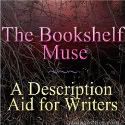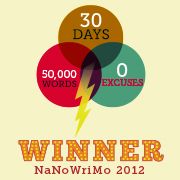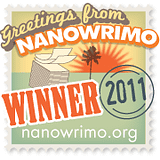 Here you will find a selection of the best of the blogsphere from the past week. Starting this week you’ll find a NaNoPrep section about halfway down. Grab your coffee, straighten the glasses or spritz those contacts and above all – enjoy!
Here you will find a selection of the best of the blogsphere from the past week. Starting this week you’ll find a NaNoPrep section about halfway down. Grab your coffee, straighten the glasses or spritz those contacts and above all – enjoy!
Inform & Inspire
J.A. Konrath: Quitter Quitter. “I was on Kindleboards reading about the reaction to my last blog post where I shared my numbers. During the discussion, someone brought up all the writers who have given up. It reminded me of a blog I wrote back in 2005, called Quitting. It’s worth reading. Go do it. You might also want to check out the comments, because I drop a lot of my philosophy about what it takes to succeed. Keep in mind, when I wrote this, I was netting about $25k a year writing.”
Christine Carter: How to Avoid Burnout—or a Breakdown. “Feeling maxed-out? Like you’d like to lie down so badly you are having “hospital fantasies”? (Not familiar with that term? Hopefully you aren’t as tired as this woman, who writes about her hospital fantasy: “I stumbled back to work when my son was 6 weeks old. He had colic and chronic ear infections, so I really didn’t sleep for a year. No exaggeration. I would fantasize about having a minor car accident on the way to work. Nothing serious—just enough to lay me up in the hospital for a few days so I could sleep!”)”
Writing
Ali Luke: Four Ways to Cut Your Novel’s Draft (and Make Your Story Stronger) “Is your novel looking a little bloated? Do you have a sneaking feeling you’ve repeated yourself a few times? Are some of your scenes really just unnecessary padding between episodes of action? Believe me, I’ve been there. I cut my novel Lycopolis from 135,000 words (Draft 5) to 85,000 words (Draft 6). It made for a much stronger novel, and I’m hugely grateful to my editor Lorna Fergusson for her invaluable help in deciding what to cut.”
Ava Jae: How to Fast Draft. “NaNoWriMo is nearly here. And reaching 50k at the end of the month, my friends, requires fast drafting. So for those of you who are new to the mystical ways of writing faster than the Energizer bunny on speed, here are five quick tips to help you get through your first draft quickly.”
Jami Gold: Does Fast Drafting Create Editing Nightmares? “Last week, we discussed how we can plan our story and avoid writing a “hot mess.” With NaNoWriMo almost upon us, now is the time to think about basic planning for plot and character arcs so we end up with a coherent story. But what about the writing quality itself? NaNo writing—where we have the pressure to write 50K words in 30 days—is similar to fast drafting or word sprinting, like on Twitter’s #1k1hr hashtag.”
Marcy Kennedy: How to Successfully Write Omniscient POV. “In case you’re not sure what I’m talking about, omniscient POV is when the story is told by an all-knowing narrator. That all-knowing narrator is the author, and the story is told in his or her voice rather than in any particular character’s voice. If you’re thinking about writing in omniscient POV, there are three criteria you need to meet to make it work.”
Roz Morris: Dialogue special part 1: how do we get characters talking? “Some manuscripts I see have no dialogue, or very little. There will be plenty of description, back story and even action, but the writer won’t have allowed the characters to step out of the narration and express themselves and interact with others. If there are conversations, they will mostly be reported instead of shown ‘live’…”
Susan Spann: 25 Things You Need To Know About Writing Mysteries. “Mystery offers plenty of room for variation, too. Murder is universal—it can happen in any setting and any time. A sleuth can be a professional, an amateur, or a NINJA (though I’ve already done that last one), and your victim and method can vary just as widely. One warning, however: killing your imaginary friends is a lot like eating potato chips. Nobody I know can stop with one.”
Writer Support
Kristine Kathryn Rusch: The Business Rusch: Carrots And Sticks. “Once upon a time, maybe five years ago, I used to wake up and figure in my head which deadlines I needed to tackle that day. The most critical, the hardest, or the ones with the most cache/money/interest always got put in line first, and then I would build everything else around those. I had several systems for this, including one on my paper calendar, a different one on my computer calendar, all with reminders and targets and completion dates.”
Michael Cahill: How Independent and Self-Published Authors Can Get Health Insurance with the Affordable Care Act. “With all the fanfare going on with the US government this month, this guest post by Michael Cahill, a health insurance writer is particularly timely. In this post he spells out what the Affordable Care Act means for us indie writers living in the US, and what you need to do in order to benefit from it.”
Elizabeth S. Craig: Traditional Publishing: One Reason Not to Choose It. “The Bookseller’s and FutureBook’s annual publishing survey. Porter Anderson in his weekly Writing on the Ether column for industry expert Jane Friedman’s blog, quoted Sam Missingham: “Traditionally published authors say they need more marketing and publicity support. But self-publishing authors say they want to get contracts because they think a publisher will give them the very marketing and publicity support the traditionally published writers say they don’t get.” It’s time to put this marketing myth to bed. Marketing support should not be your reason to go to traditional publishing, y’all.”
Susan Spann: The Key to the Competent Query. “Many authors feel great angst about queries. There’s so much talk of perfection, and many authors fear the process because they worry that “the perfect query” lies beyond their grasp. Don’t fear – you do not have to be perfect. You simply have to write a query that does (and does not do) a few specific things – I call it a COMPETENT query.”
NaNoPrep
Alexandra Sokoloff: Nanowrimo Prep: Story Elements Checklist. “As any of you who are brainstorming Index Cards right now have found, this is not an orderly process. You will be coming up with scenes in no order whatsoever, all over the structure grid. Some that you will have no idea where to put. And so while this week I will be working ahead through story structure in a relative order, I want to re-post the whole general Story Elements Checklist, so you have a whole overview of scenes and story elements you will be needing beyond whatever act we happen to be talking about at the time.”
Kristen Lamb: With a trifecta of excellent prep posts
“Creative people are a lot like tigers. We do a lot of what looks like laying around and warming our bellies in the sunshine. Yet, what we’re really doing is powering up because, once we go after that first draft, those words can be more elusive than a gazelle that’s doping. Regular folks who clock in and clock out of jobs in cubicles are grazers. They do the same routine day after day. *munch, munch, munch*. I feel this is often why creative people feel so stifled in these environments. We’re tigers stuffed in a non-tiger role. TIGER BLOOD!“
Preparing for NaNoWriMo & Feeding the Muse to Go the Distance
Fueling the Muse for NaNoWriMo
How to Give Your NaNo Story a Beating Heart and a Skeleton
Publishing
Jane Friedman: Is Self-Publishing the Most Important Transformation in the Publishing Industry? “Today I attended Frankfurt Book Fair’s CONTEC conference. The name CONTEC represents the marriage between “content” and “technology,” and featured more than sixty speakers from twenty countries. At the end of a very full day of keynotes and interactive sessions, an editor from Publishers Weekly shared his main takeaway in the conference ballroom: “The self-publishing discussion is the only conversation we need to be having today.”
Hugh Howey: The Future of Books. “What you see above is Augmented Reality, or AR. Unlike Virtual Reality (VR), which replaces what we see with a new world, AR blends the real and the make-believe into one seamless whole. As young as this field is, it already achieves mind-blowing results. The first time I saw anything like this, it was in the Lego store in NYC. There, you can hold a Lego box set up to a monitor and watch the finished Lego set hover over the box. It’s freaky and cool. I think it’s the future of picture books.”
Marketing
Darcy Pattison: Writing with Fans in Mind: What Will I Put on the Website? “I quoted a study that said fans come looking for certain things on an author’s website. I am working on a draft of my new story this week and that study keeps haunting me. Am I providing any of these things on a regular basis? Is there any reason for a fan of my writing to keep coming back to my website? These thoughts are starting to change how I write. Now, I also have open a second file that is a list of things to put on the website to go with this book.”
Anne R. Allen: Social Media Secrets for Authors, Part IV: How Not to Spam. “If you’ve ever wondered why unsolicited Internet advertising is named after a perfectly innocent meat product, blame Monty Python. In a famous 1970 sketch, the customers in a café are constantly drowned out by a chorus of Vikings singing “Spam, Spam, Spam, Spam… Lovely Spam! Wonderful Spam!” Conversation is impossible because of the “spammers.”
Rae Hoffman: Yes Virginia, Google+ Can Directly Impact Your Search Rankings. “Every time I see an article about how Google +1s currently have no direct impact on search rankings, I cringe a little bit. Not because I believe Google +1′s DO currently have a direct impact on your search engine rankings. The reason I cringe is because so many people seem to read a quote like the below…”
Technology
Derek Murphy: How To Make Your Own Free Book Cover In MS Word. “This will be a ‘crash course’ in the minimal skills you need to create a winning cover in MS Word. You’ll learn how to use Word to blend images, add layers and transparency, use font effects and space letters (kerning), strip background, and the general principles of cover design. These instructions are for MS Word 2010, so they won’t work for everyone, but if you have an older or newer version of Word, the process will be similar.”
Phi Tran: These Augmented Reality Glasses Makes Star Trek’s Holodeck a Reality. “If you’re ever dreamt of experiencing a Holodeck, then you’ve been waiting for this day. More precisely, you’ve been waiting for these CastAR Augmented Reality Glasses that brings sci-fi holographic projections to life.“









Pingback: Mind Sieve 10/21/13 | Gloria Oliver
So much great stuff here, Gene! Those NaNo posts are convincing me to give it a try. I guess I’d better finish plotting! Have a great week!
Pingback: Monday Mentions: Erotica Panic, Kitty Face & Scottie Pinwheels | AMY SHOJAI'S Bling, Bitches & Blood